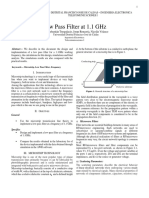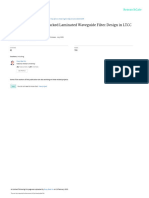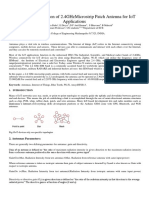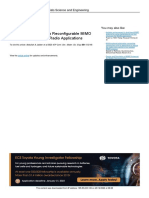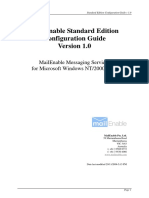Professional Documents
Culture Documents
Design of X-Band Micro Strip Line / Strip Line Filter: Y. Murali Mohan Babu, P.A.Harshavardhini, G.C.Narasimhulu
Design of X-Band Micro Strip Line / Strip Line Filter: Y. Murali Mohan Babu, P.A.Harshavardhini, G.C.Narasimhulu
Uploaded by
Dr.P.A.Harsha VardhiniOriginal Description:
Original Title
Copyright
Available Formats
Share this document
Did you find this document useful?
Is this content inappropriate?
Report this DocumentCopyright:
Available Formats
Design of X-Band Micro Strip Line / Strip Line Filter: Y. Murali Mohan Babu, P.A.Harshavardhini, G.C.Narasimhulu
Design of X-Band Micro Strip Line / Strip Line Filter: Y. Murali Mohan Babu, P.A.Harshavardhini, G.C.Narasimhulu
Uploaded by
Dr.P.A.Harsha VardhiniCopyright:
Available Formats
IJECT Vol. 2, Issue 3, Sept.
2011 ISSN : 2230-7109(Online) | ISSN : 2230-9543(Print)
Design of X-Band Micro strip line / Strip line Filter
1
Y. Murali Mohan Babu, 2P.A.HarshaVardhini, 3G.C.Narasimhulu
Dept. of ECE, SSITS, Rayachoty, AP, India
1
2
Dept. of ECE, VMT W, Hyderabad, AP, India
3
Kadapa, AP, India
Abstract is built using a high ‘Q’ cavity in contrast to low frequency
The rapid growth of wireless and mobile communications has filters that use lumped inductors and capacitors. The paper
stimulated the development of multi layer filter technology. contains design, development & fabrication of band pass
Band pass filters are essential components in communications filter in X-band using strip line and micro strip techniques for
systems. This growth of wireless and mobile communications frequencies between 9700MHz to 9900MHz These filters are
has placed an increasing demand for new technologies to to be designed for high rejection at 9475MHz is 50dB and
meet the challenge in meeting size, performance, and cost 10125MHz is 50dB.
requirements. For this purpose, there has recently been These filters are specially used in Radar applications and in
increasing interest in band pass filters. The paper work covers light cambact aircrafts. With the added tool of the impedance
design, development of band pass filter in X-band using strip or admittance inverter, a number of transmission line filters can
line and micro strip techniques. These filters are specially used be analyzed and designed. Like directional couplers, coupled
in Radar applications. transmission lines have frequency sensitive coupling, and can
be analyzed by the even-odd mode method.
Keywords We can determine even and odd impedances of each coupled
Micro strip line, Strip line Filter, Coupled Line Filter, insertion line section as
loss and VSWR. Zek+1/ Zc = 1+ Zc/ Kk, k+1 + Zc 2 / K2 k, k+1 (1)
Z0k+1/ Zc = 1- Zc/ Kk, k+1 + Zc 2 / K2 k, k+1 (2)
I. Introduction Where k=0, 1, ...n.
Filters with different configurations are essential components
in modern communications and these are generally used as II. Steps followed in Work
signal rejection for unwanted signals and simultaneously allow 1.Selection of topology (Micro strip or strip line) to meet required
the wanted signals in required bands. One of the important specifications.
parameter in modern communications is isolation between 2.Selection of substrates to meet the size and environmental
channels in a given bandwidth. Due to this, these components requirements.
are becoming essential in modern communications. 3.EESOF is used as a design tool to analyze the filter
performance and optimization techniques shall be used to
The paper work deals with design and development of a micro meet the specifications.
strip filter at X-band and this shall be used in local oscillator 4.AutoCAD shall be used for Layout.
chain for X - band transceiver. Microwave filters [7] are two-port, 5.Assembly involves connectors and package (housing).
reciprocal, passive, linear devices that attenuate heavily the 6.Network Analyzer shall be used for measurements of insertion
unwanted signal frequencies while permitting transmission loss, rejections at required frequencies and VSWR.
of wanted
III. Substrate
frequencies. The practical filters have small non zero attenuation The first step in the design of microwave integrated circuit [9]
in the pass band and a small signal output in the stop band is the choice of the substrate and selection of the substrate
due to the presence of resistive losses in reactive elements depends upon three major factors and they are
and propagating medium. Applications can be found in virtually 1. Type of the Fabrication Technology i.e.,
any type of microwave communications, radar, or test and Monolithic or Hybrid.
measurement system. 2. Type of the Transmission
3. Frequency band of operation.
The filter function of band pass is obtained by multiplying the Monolithic generally use ceramic type of material such as
filter functions of a low pass and of a high pass in the frequency Alumina (Er =10.2) and BeO material (Er =35 to 84). And these
domain, where the cut-off frequency of the low pass is higher are called semiconductor substrates. Hybrid MICs [8] generally
than that of the high pass. Many of the band pass filters use dielectric substrate, which are isotropic in nature.
are used to enhance the signal-to-noise ratio of illumination
systems. In designing a filter [1-6], the important parameters IV. The Properties of Substrate
like pass bandwidth, stop band attenuation, and input and out 1. Low Dissipation Factor
impedances, return loss, insertion loss, group delay and etc. 2. Polished Surface
are generally considered. 3. Minimum variation of the dielectric constant and dissipation
factor with temperature
The practical filters have small non zero attenuation in the 4. Uniformity of the Thickness & Dimensional stability and
pass band and a small signal output in the stop band due having high Thermal Conductivity.
to the presence of resistive losses in reactive elements and
propagating medium. Filters are frequency selective circuits
that are made up of reactive components. A microwave filter
114 International Journal of Electronics & Communication Technology w w w. i j e c t. o r g
ISSN : 2230-7109(Online) | ISSN : 2230-9543(Print) IJECT Vol. 2, Issue 3, Sept. 2011
decided to incorporate an amplifier before filter to compensate
9 - Section Microstrip Filter at 9.8GHz on Er=3.38, 20mil
0
the loss in local oscillator path.
-10
-20
V. AUTO CAD LAYOUT
-30
-40
The designed physical parameters such as length, width and
spacing are used to make layout as per required mechanical
dB
-50
-60
housing. This means the input connector position and the
-70
-80
output connector positions shall be taken care in layout. The
-90 ACAD layout is as shown in the Fig.5.
9400 9500 9600 9700 9800 9900 10000 10100 10200
MHz
Return Loss Insertion Loss
Fig. 1: Comparison of Return loss and Insertion loss of 9-section Stripline Filter at 9.8GHz BW=200 MHz,
Microstrip line filter. Er=3.38, 20mil X 4
1.1 All Dimensions are in mm
9 - Section Microstrip Filter at 9.8GHz on Er=3.38, 20mil
0 40
7.86
0.3
1.38
-10 35
1.68
-20 30
1.76
-30 25
50.8
dB
-40 20
-50 15
1.15
4.16
-60 10
-70 5
-80 0
9400 9500 9600 9700 9800 9900 10000 10100 10200
MHz
Insertion Loss VSWR 46.62
Fig. 2: Comparison of VSWR and Insertion loss of 9-section
Microstrip line filter. Fig.5: Strip line filter at 9.8GHz with
bandwidth =200MHz, Er=3.38 and B=20*4 mil
9 - Section Stripline Filter at 9.8GHz using Er=3.38
-10 VI.Testing procedure OF the Filter
-20
-30
A. Test Instrument
dB
-40
-50
HP 8757XC Scalar Network Analyser can cover a frequency
-60 range 10 MHz to 20 GHz and these instruments can perform the
-70
frequency response following measurements on any microwave
-80
9400 9500 9600 9700 9800 9900 10000 10100 10200 component.
Insertion Loss measurement
MHz
Return Loss Insertion Loss
Return loss measurement
Fig. 3: Comparison of Return loss and Insertion loss of 9-section Basically the 8757XC consists a source, a detector, a reflection
Strip line filter. detection bridge and step attenuator to control power
9 - Section Stripline Filter at 9.8GHz using Er=3.38
output.
0 40
-10 35 B. Basic Network analyser measurement theory
-20 30 The analyser has an RF signal source that produces an incident
-30 25
signal that is used as a stimulus to the device under test (DUT).
DUT responds by reflecting a portion of the incident signal
dB
-40 20
-50 15
-60 10
and transmitting the remaining signal. If the DUT is passive,
-70 5 some of the transmitted signal will be absorbed, indicating a
-80 0 lossy device. If the DUT is active, the transmitted signal may
9400 9500 9600 9700 9800 9900 10000 10100 10200
MHz be amplified, indicating the device has gain. Fig.6 shows how
Insertion Loss VSWR
a device under test responds to an RF source stimulus.
Fig. 4: Comparison of VSWR and Insertion loss of 9-section
Strip line filter. C. Test Procedure
The Insertion Loss, VSWR and rejections at specified frequencies
When compared with micro strip line 9–section filter (Quasi- are
TEM), this is a strip line filter (TEM) and we can expect reduction Specifications
in insertion Loss. Change from micro strip line to strip line Insertion Loss : 2.5dB (max)
using same Er=3.38, 20mil leads to improve in insertion loss VSWR at both the ports : 2:1
and same order of performance is expected in return loss and Rejection @ 9473MHz : 50dB (min)
rejections. So a 9 - Section strip line filter is fabricated using @ 10127M : 50dB (min)
Er=3.38, B=20mil four substrates. The simulated insertion loss
is -8Db and it is more than the customer specification.We can Arrange the test setup as shown in Fig. 5.3 and set according
see the comparisons between some properties from Fig.1 to 4. to it. Measure the insertion loss, Insertion loss variation over
This is due to the loss tangent of the substrate (0.002) and it is band width, rejections at required frequencies and VSWR at
w w w. i j e c t. o r g International Journal of Electronics & Communication Technology 115
IJECT Vol. 2, Issue 3, Sept. 2011 ISSN : 2230-7109(Online) | ISSN : 2230-9543(Print)
port1 and port2 from the setup and record the readings in VIII. DESIGN OUTCOME AS PER EESOF SOFTWARE
test data sheet.
A. Electrical
D. Simplified Network Analyser block diagram 9 section Strip line Filter using Er=3.38 B=80mil (4 X
The forward transmitted signal (Routed to the input B) and the 20mils)
reflected signal (Input A) are measured by comparison to the Frequency Band : 9.7 to 9.9 GHz
incidence signal. The reverse transmitted signal (Routed to Insertion loss : 8.5 dB (max)
input A) and the reflected signal (input B) are also measured Rejection @ 9473MHz : 61dB (min)
by comparison to the incident signal. The analyser couples @ 10127MHz : 61dB (min)
off a small portion of the incident signal to use as a reference VSWR at all port : 1.1:1
signal (routed to input R). Sweeping the source frequencies, the
analyser measures and displays the response of the DUT. B. Mechanical (Using Auto CAD )
L x W for PCB : 50.8x25.4 mm
Simplified Block Diagram
IX. Performance Achieved
Source Incident
Signal
A. Electrical
Transfer
Switch
Frequency Band : 9.7 to 9.9 GHz
Insertion loss : 8.7 dB
R
Rejection @ 9473MHz : 49dB (min)
A B
@ 10127MHz : 49dB (min)
VSWR at all port : 2.2:1
Port 1 Port 2
DUT
B. Mechanical
Forward Transmission L x W for PCB : 50.8x25.4mm
Reverse Transmission
The testing is done by giving the input signal power at port 1 and
measure the power at port1 and port2. These measurements
Fig. 6: Simplified Network Analyser block diagram give S11, S21 respectively. If the power is fed at port2 and
measure at port2 and port1, the measurements give S22, S12
E. Instrument Setting respectively. For ideal symmetrical filter the S11 and S22 are
Network Analyzer: the same and S21 and S12 are the same.
Start frequency : 9.4 GHz
Stop Frequency : 10.2 GHz The testing results obtained by giving the input at port1 are
Power Level : 16 dBm shown in table 6.1. It gives the worst VSWR value as 2.2 over the
Measurement 1 settings band 9700MHz to 9900MHz. The maximum value of insertion
Parameter : Insertion Loss (S21) loss over the same pass band is 8.7dB. Compared with this
Scale : 10dB/Div 8.7dB insertion loss, the rejection at 9473MHz or 10127MHZ
Ref Level : 0 dB is more than 49dB.And with reference with centre frequency
Measurement 2 settings insertion loss (3.9dB) it is 54dB.
Parameter : VSWR (S11)
Scale : 1 /Div The testing results obtained by giving the input at port2 are
Ref Level : 1 SWR shown in table 6.2. It gives the worst VSWR as 1.69 in the same
band. The maximum value of insertion loss is almost same as
VII. SPECIFICATIONS AS PER THE CUSTOMER the above. The rejections are also the similar. The comparison
REQUIREMENT between input VSWR (S11) and output VSWR (S22) over the
pass band is shown in table6.3.
A. Electrical
Frequency Band : 9700 to 9900 MHz Table 1 : Markers (cursors) of Fig.6.1 and its VSWR and Insertion
Insertion Loss : 2.5dB (max) loss values
Due to non-availability of low loss substrate (Er=2.2, 20mil), it Frequency Channel-1 (v) Channel-2 (dB)
is decided to use Er=3.38, 20mil with loss tangent of 0.002, 1 9.474ghz 20.484 -57.944
which shall give insertion loss of 8.5dB approximately. This
2 9.7000ghz 2.212 -8.317
specification is changed to 8.5dB and a compensating amplifier
shall be used in Local oscillator. 3 9.7520ghz 1.475 -4.807
Rejection @ 9473MHz : 50dB (min) 4 9.8000ghz 1.428 -3.939
@ 10127MHz : 50dB (min) 5 9.8520ghz 1.544 -4.692
Input/Output VSWR : 2:1 6 9.9000ghz 1.809 -8.768
Connectors : SMA (f) 7 10.128ghz 13.121 -57.120
B. Mechanical Note: Channel 1 and channel 2 are used to measure S11 and
L x W x H (max) :50 x 40 x 20 mm S21 respectively
116 International Journal of Electronics & Communication Technology w w w. i j e c t. o r g
ISSN : 2230-7109(Online) | ISSN : 2230-9543(Print) IJECT Vol. 2, Issue 3, Sept. 2011
Table 2: Markers (cursors) of Fig.6.2 and its VSWR and insertion shall give better results.
loss values
Frequency Channel-1 (v) Channel-2 (dB) XI. Future Scope
1 9.4740ghz 18.62 -58.57 The insertion loss of this filter can be decreased by using low loss
tangent substrate. This type of filters can be used in frequency
2 9.7000ghz 1.33 -8.208
synthesizers to get multiple signals from a common source such
3 9.7520ghz 1.683 -4.659 as OCXO where phase coherency can be maintained.
4 9.8000ghz 1.697 -3.934 Similar filters with same design concept can be used in
5 9.8520ghz 1.404 -4.692 microwave communication and Radar bands such as
6 9.9000ghz 1.239 -8.768 Radar Band: 1.2-1.4GHz, 2.7-2.9GHz, 17-17.5 and 17.5-18GHz.
7 10.128ghz 15.189 -57.12 Communication Band: 1.7-2.2GHz, 5.9-6.4GHz, 7.2-7.7GHz
and 14-14.5GHz
Note: Channel 1 and channel 2 are used to measure S22 and
S12 respectively Generally the strip line filters [2] are cascaded separately and
require different types of adaptors for integration. To reduce
Table 3: Comparison of Input VSWR, Output VSWR and Insertion the space or volume, this concept can be extended in multilayer
Loss of 9- Section strip line Filter PCB to fabricate inbuilt filters and to increase the components
S.No Frequency Input Insertion Output density. The added advantage in multilayer PCB is that filters
(MHz) VSWR Loss VSWR can be using broadside coupling.
(S21)
1 9474 --- -57.9 4 --- References
2 9700 2.212 -8.317 1.330 [1] Denis, S., C. Person, S. Toutain, B. Theron, and S. Vigneron,
3 9750 1.475 -4.807 1.683 “Parallel coupled microstrip filter with phase difference
4 9800 1.428 -3.939 1.697 compensation,” Electronics Letters Vol. 31, No. 22, 1927–
5 9850 1.544 -4.692 1.404 1928, 1995.
6 9900 1.809 -8.768 1.239 [2] Bharathi Bhat, Siban Koul, “Strip line-like transmission
7 10127 --- -57.12 ---
lines for microwave integrated circuits”, John Wiley & sons,
New York, 1989.
X. Conclusions [3] J.S.Wong, “Microstrip Tapped-Line Filter Design”, IEEE
Trans. Microwave Theory Tech.,vol. MTT-27 , No.1,Jan
A) Input VSWR (S11) 1977.
The expected input VSWR is 1.1:1 where as results showed [4] Kuo, J. T., M. Jiang, H. Chang, “Design of parallel-coupled
2.2:1. microstrip filters with suppression of spurious resonances
The reasons are as follow using substrate suspension,” IEEE Trans. on Microwave
1) In simulation we have not included SMA connector Theory and Tech. , Vol. 52, 83–89, 2004.
2) Improper input launching point [5] S. Sun, L. Zhu, “Coupling dispersion of parallel-coupled
3) The air gap between the substrates microstrip lines for dual-band filters with controllable
fractional pass bandwidths,” in IEEE MTT-S Int. Microw.
B) Insertion Loss (S21) Symp. Dig, 2005, vol. 3, pp. 2195–2198
The expected Insertion Loss is 8.5 dB, where as results showed [6] P.I.Richard, “Resistor-Transmission Line Circuits”, Proc.of
8.7dB and the expected rejections at 9474MHz and 10127MHz the IRE, vol.36, pp.217- 220, February 1948.
are more than 50dB, where as results showed around 49dB. [7] Kuo, J. T., W. Hsu, “Parallel coupled microstrip filters with
suppression of harmonic response,” IEEE Microwave and
The air gap between the substrate and the pattern increases Wireless Comp. Lett, Vol. 12, No. 10, 383–385, 2002.
the Insertion loss and reduces the rejections. The air gap makes [8] W.A.Davis, “Microwave Semiconductor Circuit Design”,
the Strip line circuit a non homogeneity structure and different Van Nostrand Reinhold, New York,1984.
modes shall form. Due to this the rejections at specified [9] David M. Pozar, “Microwave Engineering,” John Wiley &
frequencies has been reduced. sons, Inc., NEWYORK, 1998.
C) Output VSWR (S22)
The expected output VSWR is 1.1:1 where as results showed
1.69:1.
The reasons are as follow
1) In simulation we have not included SMA connector
2) Improper output launching point
3) The air gap between the substrates
Overall the Strip line Filter designed, developed and fabricated
is just meeting the customer requirements and design team
decided to use in local oscillator chain by incorporating an
amplifier. If the input and output are properly launched and the
air gap between the substrates is minimum, the measurements
w w w. i j e c t. o r g International Journal of Electronics & Communication Technology 117
IJECT Vol. 2, Issue 3, Sept. 2011 ISSN : 2230-7109(Online) | ISSN : 2230-9543(Print)
Y. Murali Mohan Babu is working
as head and associate professor
of the ECE department of Sri Sai
Institute of Technology and Science,
Rayachoty, Andhra Predesh, India.
He has ten years of teaching
experience. He has done his
B.Tech. Degree from JNTUniversity,
Hyderabad, M.E. degree in Micro
wave and Radar Engineering from
Osmania University, Hyderabad.
Currently he is pursuing his Ph.D research work in Digital Image
Processing in JNT University, Anantapur, AP, INDIA.
P.A.HarshaVardhini, working
as Associate Professor in the
Dept. of ECE, Vignan Institute of
Management and technology for
women and presently pursuing
her Ph.D from JNT University,
Hyderabad. Her research interests
are in the areas of mixed signal
VLSI Design, Integrated Circuits
and Wireless Communication.
G.Narasimhulu, has done his
B.Tech. degree from SVUniversity,
Tirupathi, AP, INDIA. His areas of
interest are VLSI, Digital Electronics
and Advanced Communications.
118 International Journal of Electronics & Communication Technology w w w. i j e c t. o r g
You might also like
- Xs Analyse Service ManualDocument170 pagesXs Analyse Service ManualPablo A. Flores78% (9)
- ELAN Guide PDFDocument57 pagesELAN Guide PDFDr. DNo ratings yet
- Family Assessment 3Document9 pagesFamily Assessment 3Georgea Beleni S. AbinesNo ratings yet
- Serviceamanual Rowe Scan 600 v02 en PDFDocument86 pagesServiceamanual Rowe Scan 600 v02 en PDFMārtiņš DreijersNo ratings yet
- 1-Bandwidth Enhancement in Band Pass Filter BPF Using Microstrip Couple Lines For WLAN 2.4GHZ ApplicationsDocument4 pages1-Bandwidth Enhancement in Band Pass Filter BPF Using Microstrip Couple Lines For WLAN 2.4GHZ ApplicationsJohn JohnNo ratings yet
- LPF Using AdsDocument5 pagesLPF Using Adsdipesh_babaNo ratings yet
- A Novel Low Cost Microstrip Bandpass FilDocument8 pagesA Novel Low Cost Microstrip Bandpass FilAllam Naveen Kumar 21MCE0006No ratings yet
- On Saw Filter Syndicate No.-01Document23 pagesOn Saw Filter Syndicate No.-01Praveen KumarNo ratings yet
- Low Pass Filter at 1.1 GHZ: Daniel Sebastián Trespalacio, Jorge Roncería, Nicolás VelascoDocument5 pagesLow Pass Filter at 1.1 GHZ: Daniel Sebastián Trespalacio, Jorge Roncería, Nicolás VelascoDaniel TrespalacioNo ratings yet
- Hfss Lab Record 306-2Document26 pagesHfss Lab Record 306-2HemanthNo ratings yet
- Compact Design of V-Band Edge-Coupled Stripline Bandpass FilterDocument6 pagesCompact Design of V-Band Edge-Coupled Stripline Bandpass FiltererpublicationNo ratings yet
- Design Techniques of Microwave Cavity and Waveguide Filters: A Literature ReviewDocument7 pagesDesign Techniques of Microwave Cavity and Waveguide Filters: A Literature ReviewTanko SuleNo ratings yet
- Miniaturised X-Band Bandpass Filter For Satellite ApplicationDocument4 pagesMiniaturised X-Band Bandpass Filter For Satellite ApplicationRabbia SalmanNo ratings yet
- Design and Implementation of Low Pass Filter Using Microstrip LineDocument4 pagesDesign and Implementation of Low Pass Filter Using Microstrip LineEmad AlsurrajNo ratings yet
- Paper MMS2018 YounesDocument5 pagesPaper MMS2018 YounesYossef ARNo ratings yet
- Hfss Lab Record 306Document12 pagesHfss Lab Record 306HemanthNo ratings yet
- DiplexerDocument5 pagesDiplexertamilarasansrtNo ratings yet
- Design of Stepped-Impedance Microstrip Line Low Pass Filter For Wireless CommunicationDocument3 pagesDesign of Stepped-Impedance Microstrip Line Low Pass Filter For Wireless CommunicationNOUREDDINE ELHAMRINo ratings yet
- A Compact Dual Wideband Bandpass Filter For Automotive Radar (AR) and 5G Millimeter-Wave (Mmwave) ApplicationsDocument9 pagesA Compact Dual Wideband Bandpass Filter For Automotive Radar (AR) and 5G Millimeter-Wave (Mmwave) ApplicationsThierno Amadou Mouctar BaldeNo ratings yet
- Dual-Band Vertically Stacked Laminated Waveguide FDocument10 pagesDual-Band Vertically Stacked Laminated Waveguide FNewton RaiNo ratings yet
- Ijettcs 2014 12 17 119Document4 pagesIjettcs 2014 12 17 119Fa Mido ChemseddineNo ratings yet
- A Frequency Transformation For Co Designed Multi Passband Multi Embedded Notch RF FiltersDocument5 pagesA Frequency Transformation For Co Designed Multi Passband Multi Embedded Notch RF FiltersSelim CanNo ratings yet
- Article 5 Jers Vol II Issue II April - June 2011 - 2Document3 pagesArticle 5 Jers Vol II Issue II April - June 2011 - 2Fa Mido ChemseddineNo ratings yet
- Design of Microstrip Hairpin Bandpass Filter For X-Band Radar NavigationDocument6 pagesDesign of Microstrip Hairpin Bandpass Filter For X-Band Radar Navigationtrance 2k17No ratings yet
- J.Ciencia - Sep2014 EhabDocument10 pagesJ.Ciencia - Sep2014 Ehabsuman uppalaNo ratings yet
- Design of Microstrip Antenna For C-Band FrequencyDocument9 pagesDesign of Microstrip Antenna For C-Band FrequencyCampaigns Of HistoryNo ratings yet
- First Evaluation FypDocument31 pagesFirst Evaluation Fyptehseenmuhammad.tmNo ratings yet
- Semi-Circular Compact CPW-fed Antenna For Ultra-Wideband ApplicationsDocument6 pagesSemi-Circular Compact CPW-fed Antenna For Ultra-Wideband ApplicationsTELKOMNIKANo ratings yet
- Design of Slotted Waveguide Antenna For Radar Applications at X Band Using MatlabDocument3 pagesDesign of Slotted Waveguide Antenna For Radar Applications at X Band Using MatlabSyed Nazim shahNo ratings yet
- Bio Report ElDocument8 pagesBio Report ElJateen RathodNo ratings yet
- A Compact MIMO T Slot Microstrip Antenna Design FoDocument8 pagesA Compact MIMO T Slot Microstrip Antenna Design FoSid Ahmed MadjidNo ratings yet
- Design of A Microstrip Filtering Antenna For 4G and 5G Wireless NetworksDocument6 pagesDesign of A Microstrip Filtering Antenna For 4G and 5G Wireless Networksshares02puddleNo ratings yet
- Design of Concurrent Dual-Band Filters For GSM Application: (ICCIP-2019) Available On: Elsevier-SSRNDocument8 pagesDesign of Concurrent Dual-Band Filters For GSM Application: (ICCIP-2019) Available On: Elsevier-SSRNAHMED ALANINo ratings yet
- Document 2 kxIV 24052015 PDFDocument4 pagesDocument 2 kxIV 24052015 PDFMichelle Anne PerlasNo ratings yet
- 100 PDFDocument3 pages100 PDFamit kumarNo ratings yet
- Welcome To International Journal of Engineering Research and Development (IJERD)Document11 pagesWelcome To International Journal of Engineering Research and Development (IJERD)IJERDNo ratings yet
- EC61-antennas Paper For ConferenceDocument7 pagesEC61-antennas Paper For Conferencedivya vadiyarajNo ratings yet
- Compact 3x1 Elements Reconfigurable MIMO Antenna ForDocument11 pagesCompact 3x1 Elements Reconfigurable MIMO Antenna ForAbdullah A. JabberNo ratings yet
- Dual-Bandpass Filters With Serial Configuration Using LTCC TechnologyDocument8 pagesDual-Bandpass Filters With Serial Configuration Using LTCC TechnologyDrAbdallah NasserNo ratings yet
- Iet V7i2395Document3 pagesIet V7i2395deepak negiNo ratings yet
- Design and Characterization of Corporate Feed Rectangular Microstrip Patch Array AntennaDocument6 pagesDesign and Characterization of Corporate Feed Rectangular Microstrip Patch Array AntennaimaculateNo ratings yet
- Reflectionless Adaptive RF Filters: Bandpass, Bandstop, and Cascade DesignsDocument13 pagesReflectionless Adaptive RF Filters: Bandpass, Bandstop, and Cascade DesignsAllam Naveen Kumar 21MCE0006No ratings yet
- A Compact Diamond-Shaped Dual-Band Bandpass Filter With Multiple Transmission ZerosDocument7 pagesA Compact Diamond-Shaped Dual-Band Bandpass Filter With Multiple Transmission ZerosAsmaa ZugariNo ratings yet
- Article - Beam FormingDocument10 pagesArticle - Beam FormingTapasya NathNo ratings yet
- A Uniquely-Fed Miniaturized Ultra-Wideband Antenna With Dual Band-Rejection CharacteristicsDocument6 pagesA Uniquely-Fed Miniaturized Ultra-Wideband Antenna With Dual Band-Rejection CharacteristicsEngr Kashi YousafzaiNo ratings yet
- Double Output 2.4 GHZ Square Frame Antenna For Doppler Wireless SensorDocument9 pagesDouble Output 2.4 GHZ Square Frame Antenna For Doppler Wireless SensorIrfan MujahidinNo ratings yet
- 4th Year Proposal NewDocument14 pages4th Year Proposal NewMeag GhnNo ratings yet
- Gte309k (Kmail - Gatech.edu: AntennasDocument4 pagesGte309k (Kmail - Gatech.edu: AntennasCat SkullNo ratings yet
- Design of Microstrip Dual-Band Filter Using Short-Circuited SIRDocument5 pagesDesign of Microstrip Dual-Band Filter Using Short-Circuited SIRerpublicationNo ratings yet
- Microstrip Patch Antenna For Wireless LAN: B. Karthik, S.P.Vijayaragavan and M.SriramDocument10 pagesMicrostrip Patch Antenna For Wireless LAN: B. Karthik, S.P.Vijayaragavan and M.SriramPraveenNo ratings yet
- Saw Filter ThesisDocument6 pagesSaw Filter Thesiskatieparkersaintpaul100% (2)
- Microwave Bandpass Filter Integrated With Notch ReDocument8 pagesMicrowave Bandpass Filter Integrated With Notch Retatto198No ratings yet
- Final Synopsis Format HP 2018Document19 pagesFinal Synopsis Format HP 2018mradurajeNo ratings yet
- Indium Tin Oxide Based Wideband Dielectric Resonator Antenna For Wireless CommunicationDocument10 pagesIndium Tin Oxide Based Wideband Dielectric Resonator Antenna For Wireless CommunicationHussain BohraNo ratings yet
- A Review of Stepped Impedance Resonators in Microwave CircuitsDocument8 pagesA Review of Stepped Impedance Resonators in Microwave CircuitsyyryNo ratings yet
- Electronics: A New and Compact Wide-Band Microstrip Filter-Antenna Design For 2.4 GHZ Ism Band and 4G ApplicationsDocument13 pagesElectronics: A New and Compact Wide-Band Microstrip Filter-Antenna Design For 2.4 GHZ Ism Band and 4G ApplicationsViệt LongNo ratings yet
- Design & Analysis of Square Microstrip Patch AntennaDocument4 pagesDesign & Analysis of Square Microstrip Patch AntennaAnonymous XZUyueNNo ratings yet
- A New Microstrip Diplexer Using Coupled Stepped Impedance ResonatorsDocument4 pagesA New Microstrip Diplexer Using Coupled Stepped Impedance ResonatorsJubril AkinwandeNo ratings yet
- Project Proposal - Comparison Microwave Low Pass FilterDocument17 pagesProject Proposal - Comparison Microwave Low Pass FilterJubril AkinwandeNo ratings yet
- Designing and Analysis of Microwave Hairpin Filter by Sanjay SinghDocument5 pagesDesigning and Analysis of Microwave Hairpin Filter by Sanjay SinghmagicecstaticNo ratings yet
- Wireless Communication in Feedback-Assisted Active SensorsDocument7 pagesWireless Communication in Feedback-Assisted Active SensorshesoyamyecgaaaNo ratings yet
- RFID Micro StripDocument4 pagesRFID Micro StripxeeshanajmalNo ratings yet
- 10 1109@ICICCS48265 2020 9120938reconfigDocument4 pages10 1109@ICICCS48265 2020 9120938reconfigFathima Thasleema NNo ratings yet
- Microwave and Millimeter Wave Circuits and Systems: Emerging Design, Technologies and ApplicationsFrom EverandMicrowave and Millimeter Wave Circuits and Systems: Emerging Design, Technologies and ApplicationsNo ratings yet
- Tos Lac SessionDocument37 pagesTos Lac SessionJoel Phillip GranadaNo ratings yet
- Assignment 6 and 7Document25 pagesAssignment 6 and 7Ken LeeNo ratings yet
- Business EthicsDocument44 pagesBusiness Ethicsiisjaffer67% (6)
- Mailenable Standard Edition Configuration Guide: Mailenable Messaging Services For Microsoft Windows Nt/2000/2003Document53 pagesMailenable Standard Edition Configuration Guide: Mailenable Messaging Services For Microsoft Windows Nt/2000/2003DTVNo ratings yet
- ExcelDocument12 pagesExcelMuhammad WaqasNo ratings yet
- Green Chemistry Recyclability Biodegradability: Green Computing Chapter 1, II & IIIDocument29 pagesGreen Chemistry Recyclability Biodegradability: Green Computing Chapter 1, II & IIItismon100% (9)
- Oxygen Cycle PPT Slides PDFDocument15 pagesOxygen Cycle PPT Slides PDFFany FabiaNo ratings yet
- Number 6 LessonDocument2 pagesNumber 6 Lessonapi-266764805100% (1)
- Chapter Three Mean Difference Analysis (T-Test, Analysis of Variance)Document55 pagesChapter Three Mean Difference Analysis (T-Test, Analysis of Variance)Yeshambel EwunetuNo ratings yet
- This Checklist Is Not Intended To Be A Complete List of The APA RulesDocument4 pagesThis Checklist Is Not Intended To Be A Complete List of The APA RulesfaramarzabediNo ratings yet
- Salv - Demo - Table - Columns Include Type Instead of Field CatalogDocument9 pagesSalv - Demo - Table - Columns Include Type Instead of Field CatalogVenkatRamanNo ratings yet
- Water Tank DesignDocument58 pagesWater Tank DesignMoHaMmAd WaHeEd88% (17)
- Answers - Animals, The Hack Driver, Making of A ScientistDocument9 pagesAnswers - Animals, The Hack Driver, Making of A ScientistmansiNo ratings yet
- Mega SkillsDocument4 pagesMega SkillsCTREQ école-famille-communautéNo ratings yet
- BS0 1Document36 pagesBS0 1qaisarmehboob82No ratings yet
- Chemical Elements of The Periodic Table Sorted by Atomic MassDocument2 pagesChemical Elements of The Periodic Table Sorted by Atomic Massabhishek negiNo ratings yet
- Same Day Thesis BindingDocument8 pagesSame Day Thesis Bindinghcivczwff100% (2)
- Storage MigrationPVmoveDocument6 pagesStorage MigrationPVmovenvns17No ratings yet
- Disciplines of ForensicsDocument11 pagesDisciplines of Forensicspoiuytrewq9115No ratings yet
- Final Letter RequestDocument3 pagesFinal Letter RequestJohn Rex VillasNo ratings yet
- G12 English Weekly Questions - Set 1 (Model Answers)Document1 pageG12 English Weekly Questions - Set 1 (Model Answers)zainab.xf77No ratings yet
- 15Z603Document2 pages15Z603Beashaj PuvvadaNo ratings yet
- Marketing Research: Lesson 3Document44 pagesMarketing Research: Lesson 3Njuguna ReubenNo ratings yet
- YANGA Question Documents Activity 3Document2 pagesYANGA Question Documents Activity 3Mr. Prince Karl LeronaNo ratings yet
- Muscular Development February 2017Document156 pagesMuscular Development February 2017ChingizAsadullaev100% (1)
- Course SyllabusDocument1 pageCourse SyllabusAustin TutorNo ratings yet








